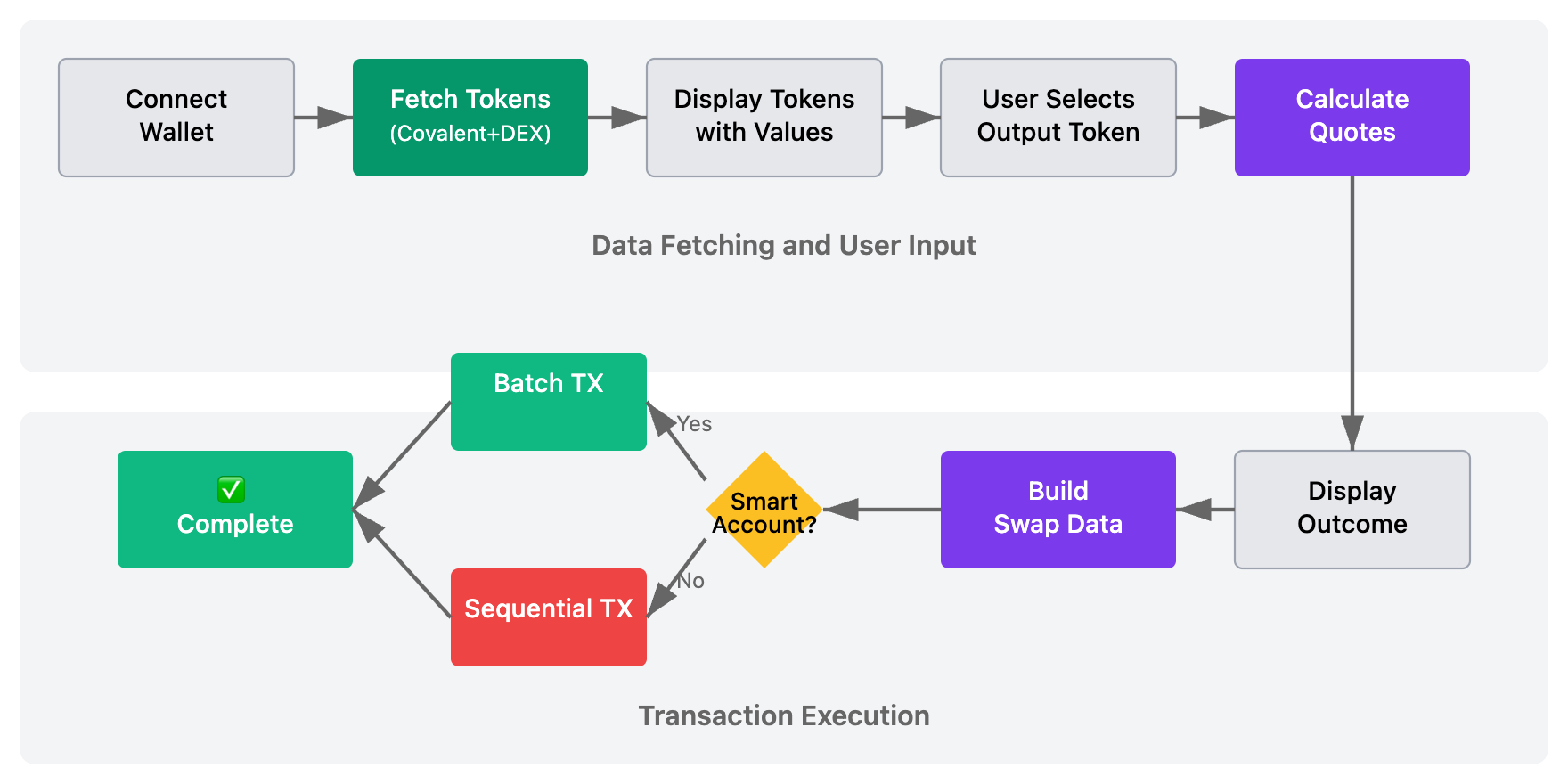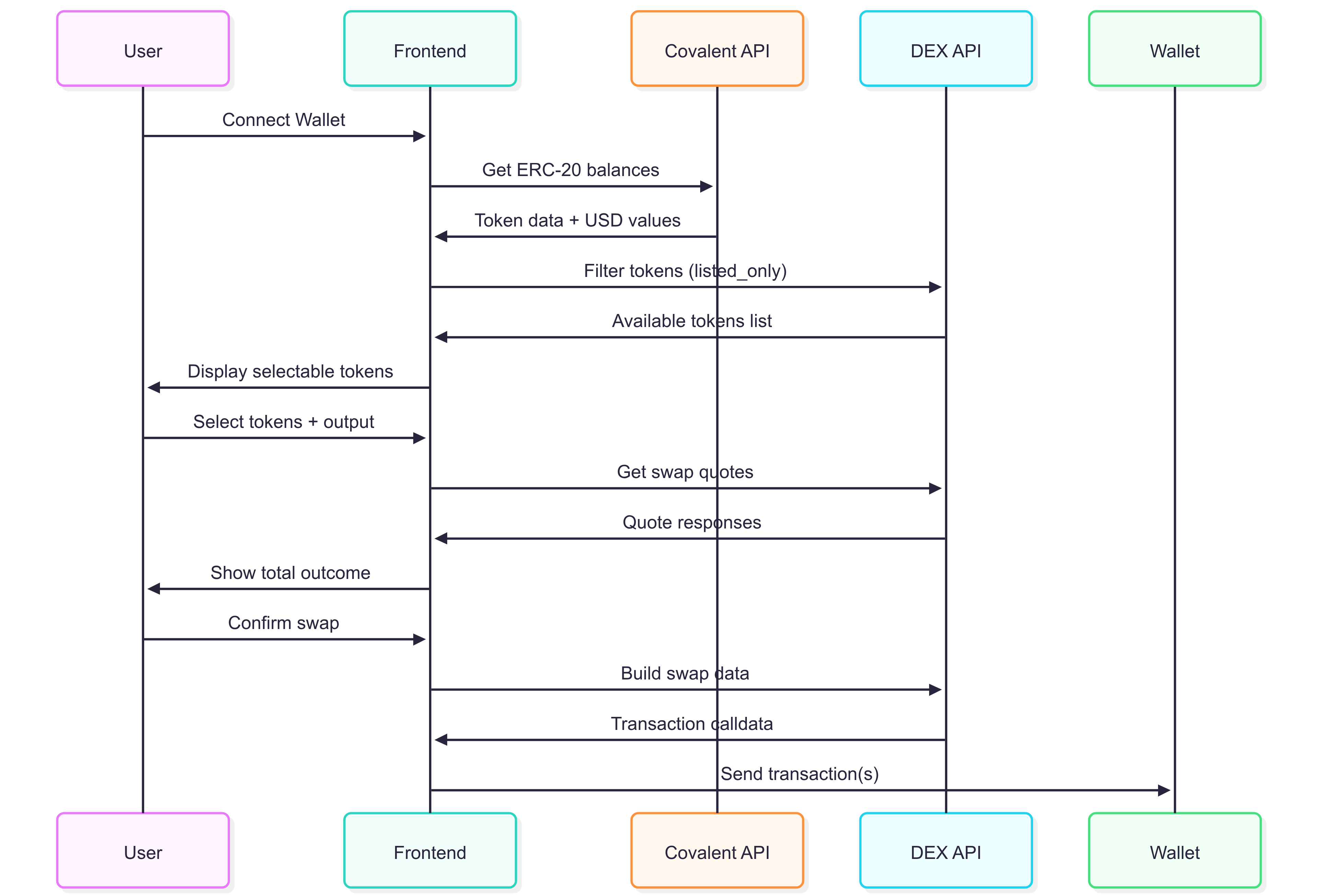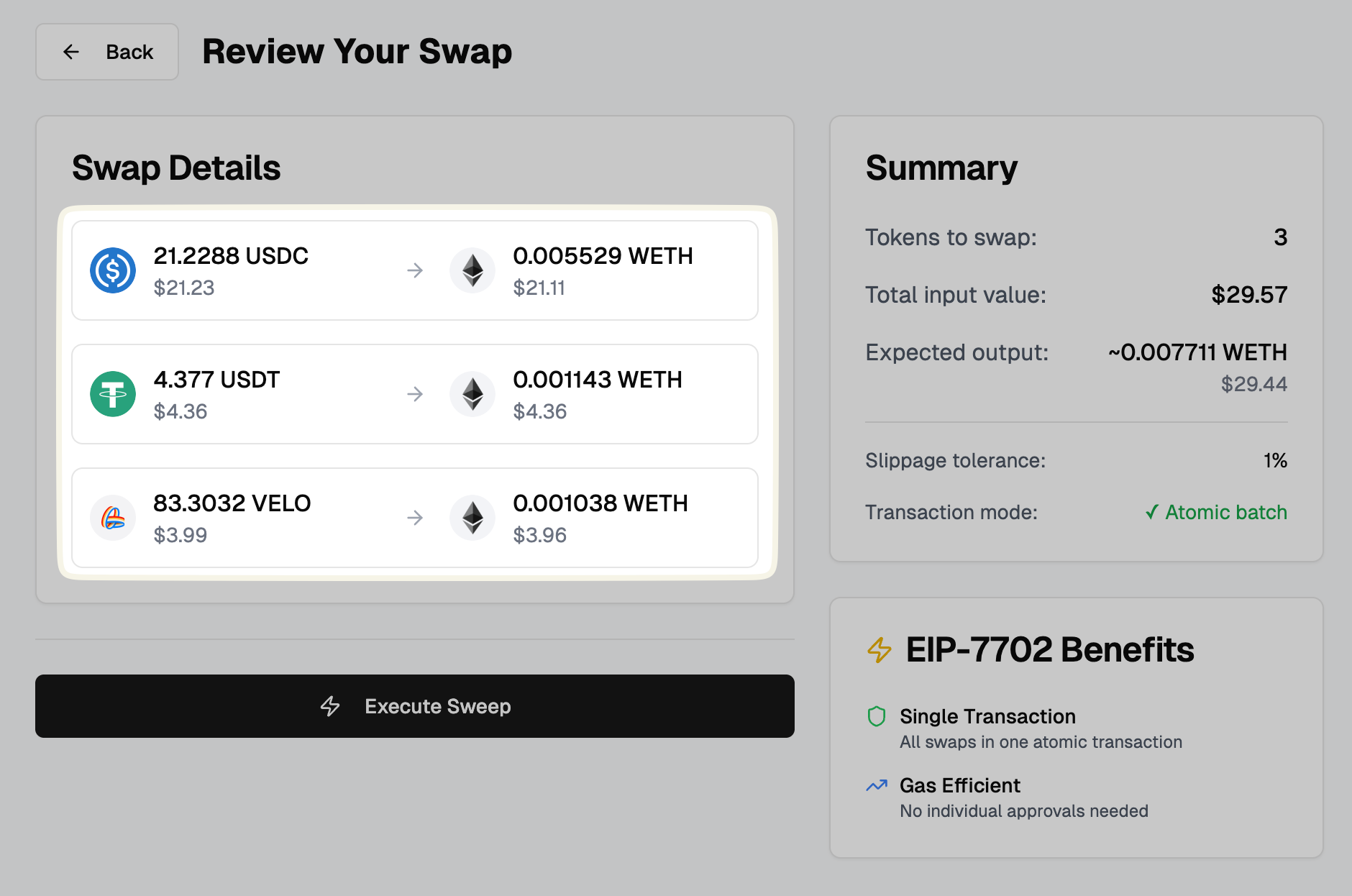11 min read
Overview
Managing multiple ERC-20 tokens across various protocols can quickly become a headache. Over time, wallets collect “dust” (tiny, low-value token amounts) and clearing them out often means multiple approvals, swaps, and fees.
EIP-7702 streamlines this process by letting you authorize a smart contract to perform multiple actions in a single atomic transaction.
In this guide, you’ll build a decentralized application (dApp) that batches multiple ERC-20 token swaps into one seamless transaction, converting them into a single asset. You’ll use Quicknode Marketplace add-ons to fetch token balances, get the best swap quotes, and execute batch swaps on the Base and Optimism networks.
By the end, you’ll have a fully functional dApp that turns tedious wallet cleanup into a fast, one-click operation.
Ready to get started?
What You Will Learn
- How to implement EIP-7702 in your dApp for batch transaction execution
- How to fetch wallet balances using the Covalent Token API add-on
- How to get optimized swap quotes using the Aerodrome and Velodrome Swap APIs
- How to combine these technologies to build a production-ready application
What You Will Need
- A Quicknode account with Base or Optimism endpoints
- The Covalent Token API add-on (free tier not available) and Aerodrome or Velodrome Swap API add-on (free tier available)
- Node.js installed on your machine
- Basic knowledge of JavaScript/TypeScript and React
- A MetaMask wallet with some ERC20 tokens and ETH on Base Mainnet or Optimism Mainnet
Application Flow & Architecture
Before diving into the code, let's understand the application's workflow from a high level. This process leverages multiple APIs to create a simple frontend experience.
The flowchart below provides a high-level overview of the application's stages, illustrating the user's journey from connecting their wallet to the final transaction.

For a more detailed technical view, the sequence diagram below illustrates the communication happening behind the scenes.

Core Technologies Explained
Our application's power comes from the combination of EIP-7702 with specialized Quicknode Marketplace add-ons. Let's break down each component.
How EIP-7702 Enables Batch Swaps
EIP-7702 is a standard that allows an Externally Owned Account (EOA) to temporarily act like a smart contract for a single transaction. This solves a major point of friction in DeFi: executing multiple operations.
Traditionally, swapping ten different tokens would require at least twenty separate actions: ten approve transactions and ten swap transactions, each demanding a signature and a gas fee.
EIP-7702 streamlines this by introducing a new transaction type that can include a delegation. This delegation authorizes a specific implementation contract to execute a series of calls on the user's behalf. This enables:
- Batch Execution: The authorized contract handles all the individual swaps within one transaction.
- Atomic Success: All operations succeed or fail together, preventing partial, failed states.
- Gas Efficiency: Combining operations into a single transaction significantly lowers total gas costs.
Technically, this functionality is exposed to dApps through the wallet_sendCalls JSON-RPC method, which we will access easily using wagmi's useSendCalls hook.
The Current EIP-7702 Landscape
EIP-7702 is still very new, and wallet support is evolving. As of writing, MetaMask has already integrated EIP-7702 into their wallet UI, providing a seamless user experience. When you initiate an EIP-7702 transaction, MetaMask will prompt you to upgrade your wallet to a smart account. This is a one-time, reversible process that delegates authority to MetaMask's audited implementation contract, EIP7702DeleGator.
Due to security concerns, it's likely that major wallets will manage their own delegation contracts rather than allowing dApps to specify arbitrary ones. Thus, wallets development is the primary focus for EIP-7702 adoption. As only a few wallets support EIP-7702, we will suggest using MetaMask for this guide.
How to Fetch Token Balances
First at the workflow level, you need to know which ERC20 tokens a user has. To do this, we'll use the Covalent Token API add-on. This add-on provides a simple and fast way to fetch token balances, instead of manually querying each token's balance.
Usage in the App
We will use the getTokenBalancesForWalletAddress endpoint to populate the user's token list.
const response = await client.BalanceService.getTokenBalancesForWalletAddress(
chainName as any,
address
)
Sample API Responses
When you query the getTokenBalancesForWalletAddress endpoint from the Covalent API, you'll receive a detailed JSON object. The most important part is the items array, where each object represents a single token in the user's wallet.
{
"address": "0x0a417ddb75dc491c90f044ea725e8329a1592d00",
"quote_currency": "USD",
"chain_id": 8453,
"items": [
{
"contract_decimals": 6,
"contract_name": "USD Coin",
"contract_ticker_symbol": "USDC",
"contract_address": "0x833589fcd6edb6e08f4c7c32d4f71b54bda02913",
"supports_erc": ["erc20"],
"logo_url": "https://logos.covalenthq.com/tokens/8453/0x833589fcd6edb6e08f4c7c32d4f71b54bda02913.png",
"native_token": false,
"is_spam": false,
"balance": "2503277",
"quote": 2.5007737,
"pretty_quote": "$2.50"
// ...
}
]
}
From this response, our application will use key fields like contract_address, balance, quote (for its USD value), and the is_spam flag to build the token portfolio list.
In addition to fetching the user's current tokens, our app also needs a list of valid tokens they can swap. For this, we use the Aerodrome/Velodrome Swap API's /v1/tokens endpoint.
{
"tokens": [
{
"address": "0xd9aAEc86B65D86f6A7B5B1b0c42FFA531710b6CA",
"symbol": "USDbC",
"decimals": 6,
"listed": true
}
// ...
]
}
How to Get Optimized Swap Quotes
Once a user selects tokens to swap, you need to find the best possible trading route. The Aerodrome Swap API (on Base) and Velodrome Swap API (on Optimism) Swap API add-ons find the optimal price across all available liquidity pools.
Sample API Responses
The /v1/quote endpoint takes a source token, destination token, and an amount, then returns the best possible exchange rate. A successful response will look like this:
{
"input": {
"token": {
"address": "0x940181a94A35A4569E4529A3CDfB74e38FD98631",
"symbol": "AERO",
"decimals": 18
},
"amount": 1,
"amount_wei": "1000000000000000000",
"price_usd": 0.8814186513914624,
"value_usd": 0.8814186513914624
},
"output": {
"token": {
"address": "0x833589fCD6eDb6E08f4c7C32D4f71b54bdA02913",
"symbol": "USDC",
"decimals": 6
},
"amount": 0.876388,
"amount_wei": "876388",
"min_amount": 0.872007,
"min_amount_wei": "872007",
"price_usd": 0.999567128249789,
"value_usd": 0.876008636392576
},
"route": {
"path": [
{
"pool_address": "0x6cDcb1C4A4D1C3C6d054b27AC5B77e89eAFb971d",
"is_stable": false,
"is_cl": false,
"hop_number": 1
}
],
"hops": 1,
"type": "direct"
},
"execution_price": 0.876388,
"slippage": 0.005
}
The v1/quote endpoint takes a source token, destination token, and amount, and returns the best possible exchange rate. We'll use this to show users the expected output before they confirm the swap.
Usage in the App
In our frontend, we call our own API route which in turn queries this endpoint. The fetched quote data is then used to populate the confirmation screen.
const tokenBalance = BigInt(token.balance)
// Convert from wei to token units for API call
const tokenAmount = formatUnits(tokenBalance, token.contract_decimals)
const quoteUrl = `/api/swap/quote?chainId=${chainId}&from_token=${tokenAddr}&to_token=${outcomeTokenAddress}&amount=${tokenAmount}&slippage=${APP_CONFIG.SLIPPAGE_TOLERANCE}`
const response = await fetch(quoteUrl)
This allows us to present a clear breakdown of the expected outcomes to the user before they sign the final transaction.

How to Build Swap Transactions
After getting a quote, the v1/swap/build endpoint returns ready-to-send transaction calldata, which is a JSON object containing everything needed to execute the swap. We primarily need the data and to fields for each transaction.
Sample API Responses
"transactions": [
{
"type": "approval",
"description": "Approve AERO for swap",
"transaction": {
"to": "0x940181a94A35A4569E4529A3CDfB74e38FD98631",
"data": "0x095ea7b3...", // Truncated for visual clarity
"value": "0x0",
"gas": "0x186a0",
"gasPrice": "0x5c7742",
"nonce": "0xc",
"chainId": "0x2105",
"from": "0x1539F7fBe3C26F5611DD4A449236180990F3e80F"
}
},
{
"type": "swap",
"description": "Swap 1.0 AERO to USDC",
"transaction": {
"from": "0x1539F7fBe3C26F5611DD4A449236180990F3e80F",
"to": "0x6Cb442acF35158D5eDa88fe602221b67B400Be3E",
"value": "0x0",
"data": "0x24856bc30...", // Truncated for visual clarity
"nonce": "0xc",
"chainId": "0x2105",
"gas": "0x493e0",
"gasPrice": "0x6af87c"
}
}
]
Usage in the App
Our use-swap-builder.ts hook calls this endpoint for every token the user has selected. It then processes each response to assemble the final array of calls.
const tokenAmount = formatUnits(BigInt(token.balance), token.contract_decimals)
const buildParams: SwapBuildParams = {
from_token: tokenAddr as Address,
to_token: outcomeTokenAddress as Address,
amount: tokenAmount, // Convert to token units, not wei
wallet_address: userWalletAddress as Address, // User's actual wallet address
slippage: APP_CONFIG.SLIPPAGE_TOLERANCE,
}
const buildUrl = `/api/swap/build?chainId=${chainId}`
const response = await fetch(buildUrl, {
method: 'POST',
headers: {
'Content-Type': 'application/json',
},
body: JSON.stringify(buildParams),
})
How to Execute Batch Transactions
The final step is to send all the prepared transactions at once. Wagmi's useSendCalls hook makes this incredibly simple and allows you to pass an array of transaction objects to be executed in a batch.
The calls parameter is an array where each object represents a single transaction we want to perform. We will construct this array by mapping over the user's selected tokens and using the data from the /v1/swap/build endpoint.
We will also set the experimental_fallback option to true, which allows the transaction to fall back to a regular transaction if the wallet does not support EIP-7702.
{
// Build transaction calls for batch execution using Swap APIs
const calls = await buildSwapCalls(
selectedTokens,
tokens,
outcomeToken,
chainId,
address
)
if (calls.length === 0) {
throw new Error('No valid swap calls could be built')
}
// Execute batch transaction using MetaMask EIP-7702, with fallback for non-supporting wallets
sendCalls({ calls, experimental_fallback: true })
}
Building the Batch Swap App
Now, let's set up the project and get the application running on your local machine.
Prerequisites
Before running the app, you need a Quicknode endpoint and the required add-ons, along with WalletConnect Project ID.
Setting Up Quicknode
- Create Endpoints: Log in to your Quicknode account and create a new endpoint for each chain you want to support. For this guide, we will use Base and Optimism.
Since these API add-ons are available on mainnet only, you will need to set up your Quicknode account with a mainnet endpoint.
- Install Add-ons:
- Once you are in your endpoint's dashboard, navigate to the Add-ons for your endpoint.
- Install the Covalent Token API add-on.
- Install the swap API add-ons for the chains you want to support:
- For Base: Install the Aerodrome Swap API
- For Optimism: Install the Velodrome Swap API
You only need to install the add-on(s) for the chain(s) you plan to support. The free tier is sufficient to get started.
-
Get Covalent API Key: Click Sign in to Dashboard next to the Covalent Token API add-on. This will redirect you to the Covalent dashboard where you can find your API key.
-
Get Swap API URLs: Click Getting Started next to the Aerodrome or Velodrome Swap API add-on. This will show you the base API URLs you need to use in your application. Use the URL before the
/v1/...part, as we will append the specific endpoints in our code. It should look something like this:https://YOUR-QUICKNODE-ENDPOINT-URL/addon/YOUR-ADDON-ID
Setting Up Reown (formerly, WalletConnect)
-
Create a Reown (formerly, WalletConnect) Project: Head to the Reown Cloud and create a new project. You can name it whatever you want.
-
Get Project ID: After creating the project, you will be redirected to the project dashboard. Here, you can find your Project ID, which you'll need to use in your application.
Setting Up the Project
- Clone the Repository: Clone the repository to your local machine.
git clone https://github.com/quiknode-labs/qn-guide-examples.git
cd qn-guide-examples/sample-dapps/token-sweeper-eip-7702
- Install Dependencies: Use your preferred package manager to install the project dependencies.
npm install
# or
yarn install
# or
pnpm install
- Set Up Environment Variables: Create a
.env.localfile in the root of the project by copying the.env.examplefile.
cp .env.example .env.local
Now, open .env.local and add relevant environment variables.
# API Keys (Server-side only)
COVALENT_API_KEY=your_covalent_api_key_here
# WalletConnect Project ID (Required for RainbowKit - client-side needed)
NEXT_PUBLIC_WALLETCONNECT_PROJECT_ID=your_walletconnect_project_id_here
# RPC URLs
NEXT_PUBLIC_BASE_RPC_URL=your_base_rpc_url_here
NEXT_PUBLIC_OPTIMISM_RPC_URL=your_optimism_rpc_url_here
# Aerodrome/Velodrome API URLs (Required for real swap functionality)
# Note: These are now server-side only
AERODROME_BASE_API=your_quicknode_aerodrome_base_api_here
VELODROME_OPTIMISM_API=your_quicknode_velodrome_optimism_api_here
- Run the Application: Start the development server.
npm run dev
# or
yarn dev
# or
pnpm dev
Open your browser to http://localhost:3000 to see the app in action.
- Test the Application: Try following steps in your app:
- Connect Wallet: Use MetaMask to connect to the app
- Switch Network: Ensure you're on Base or Optimism mainnet
- View Tokens: The app will display your ERC-20 token balances
- Select Tokens: Choose tokens to swap and an output token
- Get Quotes: Review swap estimates and total output
- Execute Batch: Confirm the transaction (MetaMask will prompt for smart account upgrade if needed)
When you're ready to deploy, platforms like Vercel or Netlify offer seamless integration with Next.js applications, providing a simple path from development to production.
Conclusion
You've successfully built a Token Sweeper dApp that demonstrates the power of EIP-7702 for batch transactions. This application showcases how Quicknode's Marketplace add-ons eliminate the need for complex backend infrastructure while providing enterprise-grade functionality.
The combination of Covalent's comprehensive token data, Aerodrome and Velodrome's optimized DEX routing, and EIP-7702's batch execution creates a seamless user experience that allows users to swap tokens with minimal friction.
If you have any questions, feel free to use our Discord server or provide feedback using the form below. Stay up to date with the latest by following us on Twitter and our Telegram announcement channel.
Additional Resources
- EIP-7702 Implementation Guide: Build and Test Smart Accounts
- AI Powered DeFi Yield Optimizer on Base
- Sample App Library
We ❤️ Feedback!
Let us know if you have any feedback or requests for new topics. We'd love to hear from you.